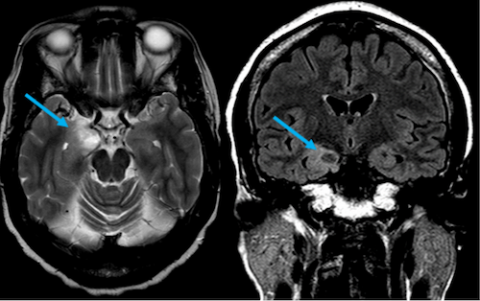Brain Tumors
Epilepsy can be caused by benign (non-cancerous) brain tumors that are very slow growing. These are called low grade tumors. Seizures may be the first sign of these tumors – persons will then undergo a magnetic resonance imaging (MRI) study of the brain which will show the tumor and its location. Seizures are focal onset, and start in the region of the tumor – the symptoms of the seizure can often (but not always) provide a clue to where in the brain the tumor is located. Sometimes the seizure can spread to both sides of the brain, leading to a focal to bilateral tonic-clonic seizure. These low grade tumors are located most commonly in the temporal lobe, but can arise anywhere in the brain.
The treatment of seizures associated with low grade tumors starts with antiseizure medications. However, in many persons, medications do not provide good seizure control, and surgery is often needed in drug-resistant cases.
What Are DNETs, Gangliogliomas, or Low-grade Tumors?
Dysembryoplastic neuroepithelial tumors (DNETs) and gangliogliomas are two types of benign (non-cancerous) brain tumors that are slow growing. These growths are similar to glial cells (provide support for the central nervous system) and neuronal cells (the functioning component of the central nervous system).
They are often associated with seizures that are difficult to control with medications. This is called drug-resistant epilepsy. These tumors are responsible for about three quarters of all brain tumor-associated epilepsy that are found after surgical resection.
These tumors are usually identified between childhood and adolescence. However, because they are slow growing, they may not be diagnosed until a later age. Typically, this will be at the time of the first seizure.
What Types of Seizures Are Seen with Brain Tumors?
Seizures are focal onset and arise in the region of the tumor. The presentation of the seizures widely varies depending on the location. However, temporal lobe seizures are the most common followed by frontal lobe seizures.
Seizures can consist of focal aware, focal unaware and at times, seizure activity can spread to both sides of the brain causing a focal to bilateral tonic-clonic seizure.
What Are the Symptoms of DNETs, Gangliogliomas, and Low-grade Tumors?
Most of these tumors are very slow growing with no signs or symptoms. They end up irritating the surrounding brain. This causes seizures, which are often the first symptoms for patients. In rare occasions, the tumor might disturb the function of the brain area where it is located. For example, if the tumor is in the speech area of the brain, the patient might start having slow or slurred speech.
How Are DNETs, Gangliogliomas, and Low-grade Tumors Diagnosed?
Most persons who present to their healthcare provider with focal onset seizures will undergo brain imaging, usually with an MRI scan.
Brain imaging will confirm that a tumor is present. A high-quality brain MRI is the best way to detect these lesions. Usually, these tumors do not pick up contrast dye, if that is given during the MRI. (see Figure 1.0 below). A brain CT scan may show some changes in the bone due to the slowly expanded tumor, but a CT scan may miss this diagnosis.

Figure 1.0: This MRI shows signs of right mesial temporal DNET.
Other brain imaging studies are not needed for diagnosis. However, imaging may be done to better understand the function of the underlying brain region where the tumor is located prior to surgical resection. Other studies which can be helpful in such cases include functional MRI (fMRI) or magnetoencephalography (MEG) to map language, sensory, motor, and visual cortex.
A definitive diagnosis can be made with a biopsy. This involves taking a small piece of the tumor but is not necessary in most cases.
What Causes Low-grade Brain Tumors?
The exact cause of low-grade brain tumors is not well understood. No specific cause has been identified.
How Are They Treated?
Because the tumor itself is benign (non-cancerous) and very slow growing, it can stay for many years without significant change in size and does not invade other brain regions. The focus of the treatment is to control the seizures that are caused by the tumor.
In most cases, anti-seizure medication is used for treatment. However, most people with low-grade tumors will have drug-resistant seizures. Surgery should be considered in cases where 2 antiseizure medications have not stopped the seizures.
In most cases, surgery is possible and often will stop seizures. If the tumor arises from a region of the brain that is responsible for important brain function, surgery might not be possible without causing loss of function. If so, doctors might choose a form of brain stimulation or neuromodulation device. The choice of which device is used is based on each individual case and the decision is often made in a comprehensive epilepsy center.
What Is the Outlook for DNETs and Gangliogliomas?
DNETs and gangliogliomas typically show little-to-no growth over the years with extremely low chances of transformation into more aggressive types of brain tumors. However, they are often associated with drug-resistant epilepsy. Many people will become seizure free or have a significant reduction in seizures with resective epilepsy surgery.
Resources
Epilepsy Centers
Epilepsy centers provide you with a team of specialists to help you diagnose your epilepsy and explore treatment options.
Epilepsy Medication
Find in-depth information on anti-seizure medications so you know what to ask your doctor.
Epilepsy and Seizures 24/7 Helpline
Call our Epilepsy and Seizures 24/7 Helpline and talk with an epilepsy information specialist or submit a question online.
Tools & Resources
Get information, tips, and more to help you manage your epilepsy.



